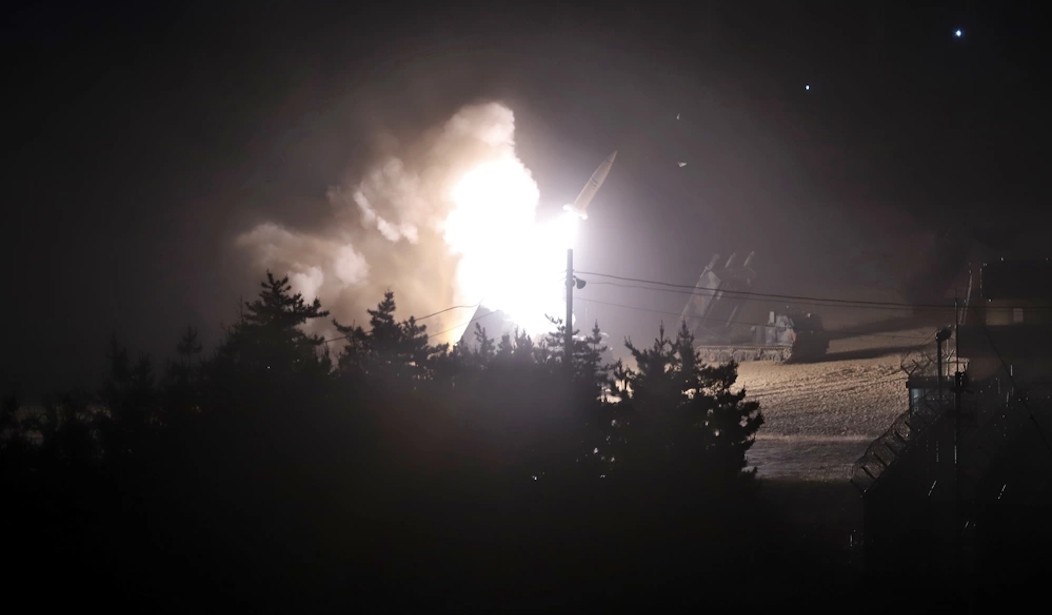A Ukrainian attack on a Russian airbase at Dzhankoy in Occupied Crimea and a Russian staging area in Berdyansk in Occupied Zaporizhzhia marks the first use of a long-range version of the Army Tactical Missile System. The Ukrainians have previously used an obsolete version of ATACMS with a range of about 100 miles. The missiles fired Wednesday night have a range of 165 miles, placing all of Occupied Ukraine within range of attack.
BACKGROUND:
Putin's War, Week 112. Ukraine Funding Passes and ATACMS Hit Crimea
Biden White House Poised to Send ATACMS Tactical Ballistic Missile to Ukraine
Russia Claims US ATACMS Missiles Hit Two Airbases in Occupied Ukraine
The attack on Dzhankoy resulted in the loss of Four S-400 missile launchers, three radars, a Nebo-M airspace surveillance unit, a command post, and a stockpile of S-400 missiles were reportedly destroyed. There have been no reports of the strike's effect on the Berdyansk assembly area.
According to a report by the New York Times, Biden (lolol) decided in February to send the longer-range missiles to Ukraine.
In a major policy shift, President Biden secretly approved the decision to send more than 100 of the longer-range missiles in mid-February, the senior U.S. official said, as well as more of the cluster munition variant. They were part of a $300 million shipment of weapons to Ukraine in March, the first new aid package for the country since funding ran out in late December.
Administration officials kept the shipment secret to avoid tipping off the Russians. When the United States has provided long-range weapons to Ukraine in the past, the Ukrainians have initially inflicted severe damage on Russian forces. But the Russians then pull back their forces and arms depots out of the weapons’ range until Ukraine can employ a new donated system with longer reach. The longer-range ATACMS were among the last major weapons systems that Kyiv wanted and the United States was reluctant to give.
Mr. Biden and his top aides dropped their reluctance to donate the longer-range missiles for several reasons, the official said. The Army decided to keep more of the missiles rather than selling them to other countries, easing Pentagon concerns about shortages. Russia’s increasing use of ballistic missiles and more attacks against critical infrastructure also bolstered Ukraine’s plea for weapons that could help counter those threats.
.@JakeSullivan46: "In February the president directed his team to provide Ukraine with a significant number of ATACMS missiles for use inside Ukraine's sovereign territory. That shipment started moving in March...those missiles have arrived in Ukraine." pic.twitter.com/7KUVzfZEMj
— CSPAN (@cspan) April 24, 2024
Jake Sullivan and the coterie of midwits he's collected to mismanage U.S. national security have fought against providing Ukraine with the weaponry it needs to bring Russia to the negotiating table...or the figurative deck of the USS Missouri.
Main Points
The M39 (mid-range) and M39A1 (long-range) were manufactured between 1986 and 2003. They are not associated with any U.S. operations plan. The current expectation is that the weapons sent to Ukraine will be drawn from "expired" stocks. Fewer than 1100 of these missiles are available.
We still don’t know how many ATACMS Ukraine is set to receive, only that they will receive them, but here to repost @ColbyBadhwar graph displaying the amount of expired ATACMS. Would be criminal if we didn’t pass them off to Ukraine especially with PrSM being received. pic.twitter.com/jJ13YAAO9k
— Dillon Payton (@dillonrpayton) April 23, 2024
Both weapons use dual-purpose improved conventional munitions, aka DPICM. This makes them highly effective against most targets.
Despite some claims, the missiles known to have been transferred to Ukraine are not suitable for an attack on the Kerch Strait Bridge. There are rumors that the later version with a unitary warhead is in the transfer package. If so, the Kerch Strait Bridge is finished.🚨🇺🇲🇺🇦 BREAKING: CNN reports the Biden Admin has informed Congress that they will provide "long-range" ATACMS to Ukraine. This would likely include the M39A1, M48, & M57. Doubtful that the newest M57E1s would be sent.https://t.co/KOOHuV3t2Q pic.twitter.com/zA988cPna8
— Colby Badhwar 🇨🇦🇬🇧 (@ColbyBadhwar) April 23, 2024
The warheads are controversial in some circles because the bomblets' dud rate is above the desired DoD dud rate of 2% (the jokes write themselves sometimes). The M39 warhead has about 950 21-ounce bomblets, while the M39A1 carries about 300. Read this Congressional Research Service paper for background on the cluster munition controversy.
Though the New York Times and Politico refer to the release of ATACMS to the Ukrainian Armed Forces as secret (see The U.S. secretly sent long-range missiles to Ukraine — and Kyiv used them - POLITICO and U.S. Secretly Shipped New Long-Range Missiles to Ukraine - The New York Times), the only "secret" was not publicly announcing the transfer. Congressional notification requirements were met before the first batch was sent last year, but Congressional leadership was informed of the pending action.
Key members of Congress were notified at the time that the secret shipment of ATACMS was included in that package, but Biden administration officials made no public mention that either type of ATACMS was bound for Ukraine.
The new Ukraine aid package requires that ATACMS be sent to Ukraine.
RELATED: BREAKING: Biden Signs Foreign Aid/TikTok Bill Into Law
A very important requirement, buried in the Ukraine aid bill, is Section 505.
— Marshall S. Billingslea (@M_S_Billingslea) April 20, 2024
It forces Biden to do what he has so far refused to do: provide long-range ATACMS to Ukraine.
But it also gives him a waiver.
In the coming days we need to watch closely how the Admin responds. pic.twitter.com/VUo4VwH2Z5
The March weapons transfer was made possible by existing funds.
The ATACMS production line produces about 500 missiles annually, of which about 200 are sold to foreign countries. The Precision Strike Missile will replace the entire ATACMS program within the next two years.
These missiles put all of Occupied Ukraine within range of Ukrainian strikes.
ATACMS will be able to cover all occupied territories of Ukraine. Expect big fireworks in the weeks to come! pic.twitter.com/e6tN39o8CN
— Roman Sheremeta 🇺🇦 (@rshereme) April 24, 2024
Russian milbloggers report that Ukraine is using decoy drones and Western intelligence platforms to map Russian radar coverage.
The panic is real! Rybar reports extensive use by Ukraine of DECOYS, that with help of western surveillance, are mapping out location of every single AD system in Crimea in preparation for multiple attacks on multiple targets (including Kerch Bridge) by Storm Shadow and ATACMS 🤣 pic.twitter.com/ueb4Xiwhh0
— ITDUDE Fella 🇮🇱🇺🇦🇺🇸 (@The_Real_ITDUDE) April 24, 2024
Bottom Line
ATACMS is not a miracle weapon that ends the war, but it does deprive Russian fixed- and rotary-wing aircraft of any secure base area within 160 miles of the front line.
If the unitary warhead ATACMS are released, the Kerch Strait Bridge and every railway bridge in Occupied Ukraine will be as good as gone.
Transferring ATACMS to Ukraine marks a catastrophic defeat for the Ukraine policy championed by Jake Sullivan for the last two years. The strategy of timidity and giving Putin "off ramps" seems to have been replaced by the policy favored by France, Poland, and most of Europe of bringing this war to an acceptable close.














Join the conversation as a VIP Member